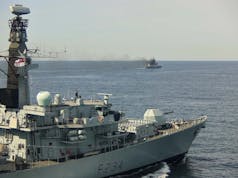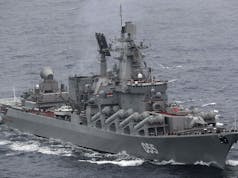There’s a new layer of defence around HMS Lancaster and her 200 crew to keep her foes at bay.
The Royal Navy say that the Portsmouth-based warship has been fitted with heavy machine-guns to fend off small, fast-attack craft – guns tested for the first time off the South Coast this week as the ‘Queen’s Frigate’ shakes off winter cobwebs.
“After a hectic 2020, the ship began this year undergoing maintenance before resuming her place in the Fleet’s order of battle having sailed on Sunday. The .50 calibre gun has long been a favourite of the Royal Marines (on WMIK Land Rovers, for example) and aircrew – it’s fitted to the Fleet Air Arm’s Wildcat and Merlin helicopters when they are providing air cover or hunting down smugglers.
But for close-protection ships either rely on the lighter general purpose machine gun (GPMG), sometimes the Minigun (a manually-operated Gatling gun) and, as a last resort, standard-issue SA80 rifles. As the name suggests the .50 heavy machine-gun – generally known as the ’50 cal’ or HMG (heavy machine gun) – spews out half inch/12.7mm diameter shells at 500-600 rounds per minute.”
Effective at ranges up to about 2,000 metres, its bullets can penetrate light armour and will tear through plastics such as RIB speed boats.
As well as gunnery, the Royal Navy say that Lancaster’s trials this week including working with Wildcats from Yeovilton by day and night to ensure they can operate the helicopter safely in all conditions, and testing her engines.













Good news that escorts will be able to mount .50 cals alongside the GPMGs and miniguns, an extra layer in between the 30 mm and the smaller stuff, I suppose.
Disappointed in the Royal Navy source article though, half the photos in the piece were of a sailor firing a GPMG rather than the .50 cal subject of the report, without any captions.
Some points regained from the perspective that the sailor interviewed was named Able Seaman Benbow.
HMS Lancaster’s twitter feed:
https://twitter.com/RoyalNavy/status/1359141564992417798?s=20
Thanks, nice little clip there- never seen that kind of shoulder brace for a .50 cal before, is it an RN thing that they use for the helicopter mount too?
Mostly used on land and ship for long range, can’t remember seeing them on helicopters before as usually not enough room
Thanks, good point about the room premium on a helicopter. I’ve mostly seen them with those “thumb paddles” on vehicles and stuff, but only on TV and stuff, I’ve no personal professional experience to go on.
As Andy has pointed out they are used on ground based weapons. I believe it is so the operator can brace themselves up against it. Especially useful when using sights. As for air mounted guns they use a different mount for the M3, as they need to for the higher rate of fire. plus aircrew tend to lean less in to their guns, so they wouldn’t need a brace.
Is this a RN first? The article gently infers that this is a new ship-mounted capability. Forgive my ignorance but the .50 cal has been round for a while, has this been tested and deployed before on surface vessels? Certainly against IRG boats and Somali pirates I would have thought this was old hat. I’m sure someone can put me right.
Nothing quite focus
s the enemys mind like being on the recieving end of a few .50 cals rounds.I can’t speak with great authority on this, but everything that I’ve read about the T45 and T23 has spoken of GPMGs and miniguns as their “light” crew served armament. .50 cals on pintle mounts is not something I’ve ever seen mentioned previously. From the 7.62 mm it then jumps up to the 20 mm or 30 mm cannons on the armament lists on Wikipedia and stuff.
No they came in to service a few years ago, 2019 i think, on the mine hunter fleet based in the middle east.
Not new.
They have been on the Bahrain based vessels for a while and have been retrofitted to UK vessels as required.
Love these weapons, while using it onboard will require quite a decent rate of rounds down, due to the nature of the threats, on land this weapon is superb used as single shots as well as rapid rate.
Yeah, so long as you keep the bugger clean. A bottle of gun oil was always the quick and easy answer to stoppages. Though the real answer was a strip and clean. For some reason compared to the GPMG the internals were always far more clagged up after firing and operating out in the sticks.
Probably using the cheap ammo bought from India!
It wasn’t the best propellant inside the cartridges. On investigation the cartridge pressure was all over the place due to poor manufacturing. It largely came down to inconsistent filling…some cartridges had more propellant than they should and others less…or none!
We Red Carded the whole Lot and disposed of it.
The warshot ammo loaded up for actual proper sorties in the HMG Pods on a Gulf Mod lynx was from western manufacturers, cost a fortune and wasn’t used for practise shoots. It had no issues.
Is it me or is there quite a lot of off axis kick?
It looks like it is a tiny bit behind the rotation axis on the mount? Or the recoilless is sticking a bit?
Either way it isn’t exactly a precision weapon and the 30mm’s will be a lot better.
I appreciate it is more than capable of shredding a fibreglass or aluminium hull at 1km so for the deference/defence in the gulf it is capable of useful goals.
RN adds WW2-era machine guns to frigate and spins step-function in defensive capability.
I’ve heard it all now. Gives them the excuse to deactivate the Sea Ceptors I guess….
1919 actualy I believe.Many other navies rely on 0.5inch brownings where we used GPMGs & miniguns. 0.5inch hit an awful lot harder to disable engines etc in attacking boats. I wonder what’s prompted the change & wether it will become the standard acrosss the escort fleet?
Your a glass half empty today!
I used to maintain 40mm Bofors (T22) , 7A Oerlikon’s(T42) and LMG Machine guns(Brens!) back in the day. They where WW1 and WW2 staples. One of the 7A mounts we had on Brum in 1988 had a barrel proof tested 1937! The 7A was about as Matelot proof as you can get and couldn’t be bettered until the 20mm Gambo came into service. Nothing wrong with weapons based on proven technology.
If anything the HMGs main disadvantage is that its a pain in the but to strip down and maintain when compared to say a GPMG or even a 20mm Gambo. That said its easier than a Mini Gun and the Bushmaster.
The HMG gives you a good range of fire between 7.62 and 30mm as well as the ability to drop a load of thumb sized HE IT rounds onto someone.
Never used one then mate I take it. Top bit of kit, give it a stable platform and this will rip shit out of most things easily at 1km plus. Second world war vintage? Dead right, it works, it’s solid and it’s quite cheap. Ideal solution for modern times methinks.
Really good at making holes in breeze blocks, especially if someone is hiding behind it. Even the standard ball round will punch fist sized holes in bricks. A very good weapon system so long as you maintain its cleanliness and have a bottle of gun oil handy.
Is the proposed fitting of the brimstone system to the 30mm cannons going to happen ? . I’m sure UKDF had an article some time back that mentioned they were trialing the missile launcher which could be fitted to the guns or something along those lines for defence against multiple small boat swarm attacks like the dafty mullahs love .
I can’t remember if it was brimstone but it was something similar ?
???????????
TAFKALPC wrote:
It was the Lightweight Multirole Missile aka Martlet
https://ukdefencejournal.org.uk/hms-sutherland-fires-new-self-defence-missile-system/
Merci ?? Knew it was something like a missile . Yes the new martlet I remember now
???????????
The Navy seem to be shying away from the dual DS30 and Martlet mount? They have yet to give an official reason. But it may be because the Martlet is not a “fire and forget” system, but a semi-active laser guided weapon, i.e. the target must be continuously illuminated by a laser for the missile to home in on. Therefor, to engage multiple targets like a swarm, you have to illuminate each one individually then move on to the next one after its hit. For a Wildcat this isn’t so much of a problem as it can vary its position and engagement range, but for ship it is a little more difficult. Perhaps we will see a future Martlet fitted with either a imaging infrared seeker of an active RF seeker to give a simultaneous engagement capability?
I don’t know If anyone saw the firing video for that trial fit. The efflux from the rocket motor firing was horrendous. On a T23 if the 30mm gun was at Red or Green 90 the motor efflux would be right onto the 30mm magazine door which is, for the uninitiated reading this, a BAD thing.
Even when the mount was facing 45 degs off ships head the efflux would cut across the cross passage or at 135 degs trash the sea boat.
The solution would need a seperate illuminator for the reasons Daveyb gave regarding lighting up the target and a seperate firing mount to stop you barbequing most of the upper deck fixtures and fittings. With the demise of GWS 26 trackers on the hangar and bridge roof there is some room now to fit something like that but the efflux would still be an issue.
That was exactly the point I made on original thread.
As well as toasting all the exposed wiring which would need either rerouting (hard as by the looks of things it leads to penetrating JB’s) or protecting.
Wiring is easy. Stick it in a conduit.
The magazine location cannot be moved and that is a massive stopper.
The sea boat is a little bit more difficult to hide ?
martlet
This – https://upload.wikimedia.org/wikipedia/commons/9/98/Mk_38_25mm_Machine_Gun_System.jpg
or this –
https://upload.wikimedia.org/wikipedia/commons/2/2d/Twin_M2HB_machine_gun.jpg
Great photos.